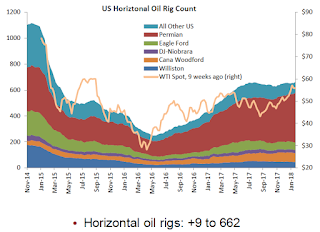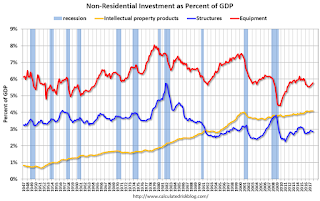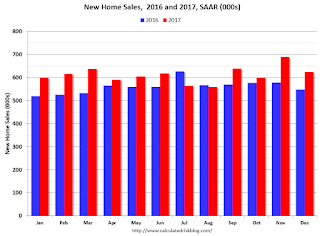by Calculated Risk on 1/28/2018 11:06:00 AM
Sunday, January 28, 2018
Vehicle Forecast: Sales Expected to Exceed 17 million SAAR Again in January
The automakers will report January vehicle sales on Thursday, Feb 1st.
Note: There are 25 selling days in January 2018, there were 24 selling days in January 2017.
From WardsAuto: U.S. Forecast: January Sets Stage for Anticipated Year-Over-Year Decline
The Wards Intelligence January forecast calls for 1.16 million LVs to be delivered over 25 selling days, resulting in a 46,430-unit daily sales rate compared with 47,442 in prior-year (24 days). The DSR is down 2.1% from like-2017.Sales had been below 17 million SAAR (Seasonally Adjusted Annual Rate) for six consecutive months last year, until September, when sales increased due to buying following Hurricane Harvey. If sales exceed 17 million SAAR in January, this will be the fifth consecutive month over 17 million SAAR. However, overall, it appears sales will be down again in 2018.
...
The resulting seasonally adjusted annual rate is 17.24 million units, below the 17.75 million in the previous month and 17.34 million year-ago.
emphasis added
Here is a table of light vehicle sales since 2000. The record year for sales was 2016, followed by 2015, both breaking the previous record set in 2000. Last year, 2017, was the fourth best year ever, just ahead of 2001.
| Light Vehicle Sales (000s) | ||
|---|---|---|
| Year | Sales | Change |
| 2000 | 17,350 | |
| 2001 | 17,122 | -1.3% |
| 2002 | 16,816 | -1.8% |
| 2003 | 16,639 | -1.1% |
| 2004 | 16,867 | 1.4% |
| 2005 | 16,948 | 0.5% |
| 2006 | 16,504 | -2.6% |
| 2007 | 16,089 | -2.5% |
| 2008 | 13,195 | -18.0% |
| 2009 | 10,402 | -21.2% |
| 2010 | 11,555 | 11.1% |
| 2011 | 12,742 | 10.3% |
| 2012 | 14,433 | 13.3% |
| 2013 | 15,530 | 7.6% |
| 2014 | 16,452 | 5.9% |
| 2015 | 17,396 | 5.7% |
| 2016 | 17,465 | 0.4% |
| 2017 | 17,135 | -1.9% |
Saturday, January 27, 2018
January 2018: Unofficial Problem Bank list declines to 101 Institutions
by Calculated Risk on 1/27/2018 06:12:00 PM
Note: Surferdude808 compiles an unofficial list of Problem Banks compiled only from public sources.
Here is the unofficial problem bank list for January 2018.
Here are the monthly changes and a few comments from surferdude808:
Update on the Unofficial Problem Bank List for January 2018. The list had a net decline of two insured institutions to 101 banks. Likewise, aggregate assets had a small decline of $200 million to $20.7 billion. A year ago, the list held 163 institutions with assets of $43.5 billion.
Actions were terminated against First South Bank, Spartanburg, SC ($238 million) and Blue Grass Federal Savings and Loan Association, Paris, KY ($33 million). Heartland Bank, Little Rock, AR ($182 million) found their way off the list through a merger partner. Added this month was Jackson County Bank, Black River Falls, WI ($253 million).
Schedule for Week of Jan 28, 2018
by Calculated Risk on 1/27/2018 08:09:00 AM
The key report this week is the January employment report on Friday.
Other key indicators include the January ISM manufacturing index, January auto sales, and the Case-Shiller house price index.
Also the FOMC meets this week, and no change to policy is expected.
8:30 AM: Personal Income and Outlays for December. The consensus is for a 0.3% increase in personal income, and for a 0.5% increase in personal spending. And for the Core PCE price index to increase 0.2%.
10:30 AM: Dallas Fed Survey of Manufacturing Activity for January. This is the last of the regional surveys for January.
 9:00 AM ET: S&P/Case-Shiller House Price Index for November.
9:00 AM ET: S&P/Case-Shiller House Price Index for November.This graph shows the nominal seasonally adjusted National Index, Composite 10 and Composite 20 indexes through the October 2017 report (the Composite 20 was started in January 2000).
The consensus is for a 6.4% year-over-year increase in the Comp 20 index for November.
10:00 AM: the Q4 Housing Vacancies and Homeownership from the Census Bureau.
7:00 AM ET: The Mortgage Bankers Association (MBA) will release the results for the mortgage purchase applications index.
8:15 AM: The ADP Employment Report for January. This report is for private payrolls only (no government). The consensus is for 195,000 payroll jobs added in January, down from 250,000 added in December.
9:45 AM: Chicago Purchasing Managers Index for January. The consensus is for a reading of 64.0, down from 67.6 in December.
10:00 AM: Pending Home Sales Index for December. The consensus is for a 0.4% increase in the index.
2:00 PM: FOMC Meeting Announcement. The FOMC is expected to announce no change to policy at this meeting.
8:30 AM ET: The initial weekly unemployment claims report will be released. The consensus is for 235 thousand initial claims, up from 233 thousand the previous week.
 10:00 AM: ISM Manufacturing Index for January. The consensus is for the ISM to be at 58.7, down from 59.7 in December.
10:00 AM: ISM Manufacturing Index for January. The consensus is for the ISM to be at 58.7, down from 59.7 in December.Here is a long term graph of the ISM manufacturing index.
The ISM manufacturing index indicated expansion in December. The PMI was at 59.7% in December, the employment index was at 57.0%, and the new orders index was at 69.4%.
10:00 AM: Construction Spending for December. The consensus is for a 0.5% increase in construction spending.
 All day: Light vehicle sales for January. The consensus is for light vehicle sales to be 17.3 million SAAR in January, down from 17.8 million in December (Seasonally Adjusted Annual Rate).
All day: Light vehicle sales for January. The consensus is for light vehicle sales to be 17.3 million SAAR in January, down from 17.8 million in December (Seasonally Adjusted Annual Rate).This graph shows light vehicle sales since the BEA started keeping data in 1967. The dashed line is the December sales rate.
8:30 AM: Employment Report for January. The consensus is for an increase of 176,000 non-farm payroll jobs added in January, up from the 148,000 non-farm payroll jobs added in December.
 The consensus is for the unemployment rate to be unchanged at 4.1%.
The consensus is for the unemployment rate to be unchanged at 4.1%.This graph shows the year-over-year change in total non-farm employment since 1968.
In December the year-over-year change was 2.055 million jobs.
A key will be the change in wages.
Note from the BLS: "Effective with the release of The Employment Situation for January 2018 on February 2, 2018, the establishment survey will introduce revisions to nonfarm payroll employment, hours, and earnings data to reflect the annual benchmark adjustment for March 2017 and updated seasonal adjustment factors. Not seasonally adjusted data beginning with April 2016 and seasonally adjusted data beginning with January 2013 are subject to revision. Consistent with standard practice, some historical data may be subject to revisions resulting from issues identified during the benchmark process." The preliminary benchmark revision showed an increase of 95,000 jobs.
10:00 AM: University of Michigan's Consumer sentiment index (preliminary for February). The consensus is for a reading of 95.0, up from 94.4 in January.
Friday, January 26, 2018
Oil Rigs "US oil rigs were up sharply"
by Calculated Risk on 1/26/2018 07:02:00 PM
A few comments from Steven Kopits of Princeton Energy Advisors LLC on Jan 26, 2017:
• Total US oil rigs were up sharply, +12 to 759
• Horizontal oil rigs were similarly up, +9 to 662
• All of the gain comes from the Permian, up 18 rigs in total
...
• The oil price continues to rise, with WTI above $66, even as the Brent spread has fallen below $5.
 Click on graph for larger image.
Click on graph for larger image.CR note: This graph shows the US horizontal rig count by basin.
Graph and comments Courtesy of Steven Kopits of Princeton Energy Advisors LLC.
Philly Fed: State Coincident Indexes increased in 37 states in December
by Calculated Risk on 1/26/2018 01:25:00 PM
From the Philly Fed:
The Federal Reserve Bank of Philadelphia has released the coincident indexes for the 50 states for December 2017. Over the past three months, the indexes increased in 42 states and decreased in eight, for a three-month diffusion index of 68. In the past month, the indexes increased in 37 states, decreased in 10, and remained stable in three, for a one-month diffusion index of 54.Note: These are coincident indexes constructed from state employment data. An explanation from the Philly Fed:
emphasis added
The coincident indexes combine four state-level indicators to summarize current economic conditions in a single statistic. The four state-level variables in each coincident index are nonfarm payroll employment, average hours worked in manufacturing by production workers, the unemployment rate, and wage and salary disbursements deflated by the consumer price index (U.S. city average). The trend for each state’s index is set to the trend of its gross domestic product (GDP), so long-term growth in the state’s index matches long-term growth in its GDP.
 Click on map for larger image.
Click on map for larger image.Here is a map of the three month change in the Philly Fed state coincident indicators. This map was all red during the worst of the recession, and all or mostly green during most of the recent expansion.
Recently several states have turned red.
Source: Philly Fed.
Note: For complaints about red / green issues, please contact the Philly Fed.
 And here is a graph is of the number of states with one month increasing activity according to the Philly Fed. This graph includes states with minor increases (the Philly Fed lists as unchanged).
And here is a graph is of the number of states with one month increasing activity according to the Philly Fed. This graph includes states with minor increases (the Philly Fed lists as unchanged).In December, 38 states had increasing activity (including minor increases).
The downturn in 2015 and 2016, in the number of states increasing, was mostly related to the decline in oil prices.
The reason for the mid-to-late 2017 sharp decrease in the number of states with increasing activity is unclear.
Q4 GDP: Investment
by Calculated Risk on 1/26/2018 11:11:00 AM
The first graph below shows the contribution to GDP from residential investment, equipment and software, and nonresidential structures (3 quarter trailing average). This is important to follow because residential investment tends to lead the economy, equipment and software is generally coincident, and nonresidential structure investment trails the economy.
In the graph, red is residential, green is equipment and software, and blue is investment in non-residential structures. So the usual pattern - both into and out of recessions is - red, green, blue.
The dashed gray line is the contribution from the change in private inventories.

Residential investment (RI) increased at a 11.6% annual rate in Q3. Equipment investment increased at a 11.4% annual rate, and investment in non-residential structures increased at a 1.4% annual rate.
On a 3 quarter trailing average basis, RI (red) is unchanged, equipment (green) is positive, and nonresidential structures (blue) is unchanged.
Recently RI has been soft, but picked up in Q4.
I'll post more on the components of non-residential investment once the supplemental data is released.

Residential Investment as a percent of GDP increased in Q4, and has generally been increasing. RI as a percent of GDP is only just above the bottom of the previous recessions - and I expect RI to continue to increase for the next couple of years.
The increase is primarily coming from single family investment and the boom in home remodeling.
I'll break down Residential Investment into components after the GDP details are released.
Note: Residential investment (RI) includes new single family structures, multifamily structures, home improvement, broker's commissions, and a few minor categories.

BEA: Real GDP increased at 2.6% Annualized Rate in Q4
by Calculated Risk on 1/26/2018 08:36:00 AM
From the BEA: Gross Domestic Product: Fourth Quarter 2017 (Advance Estimate)
Real gross domestic product (GDP) increased at an annual rate of 2.6 percent in the fourth quarter of 2017, according to the "advance" estimate released by the Bureau of Economic Analysis. In the third quarter, real GDP increased 3.2 percent.The advance Q4 GDP report, with 2.6% annualized growth, was below expectations.
...
The increase in real GDP in the fourth quarter reflected positive contributions from personal consumption expenditures (PCE), nonresidential fixed investment, exports, residential fixed investment, state and local government spending, and federal government spending that were partly offset by a negative contribution from private inventory investment. Imports, which are a subtraction in the calculation of GDP, increased.
The deceleration in real GDP growth in the fourth quarter reflected a downturn in private inventory investment that was partly offset by accelerations in PCE, exports, nonresidential fixed investment, state and local government spending, and federal government spending, and an upturn in residential fixed investment. Imports, which are a subtraction in the calculation of GDP, turned up.
emphasis added
Personal consumption expenditures (PCE) increased at 3.8% annualized rate in Q4, up from 2.2% in Q3. Residential investment (RI) increased at a 11.6% pace. Equipment investment increased at a 11.4% annualized rate, and investment in non-residential structures decreased at a 1.4% pace.
I'll have more later ...
Thursday, January 25, 2018
Friday: GDP, Durable Goods
by Calculated Risk on 1/25/2018 08:22:00 PM
Friday:
• At 8:30 AM ET, Gross Domestic Product, 4th quarter 2017 (Advance estimate). The consensus is that real GDP increased 2.9% annualized in Q4, down from 3.2% in Q3.
• Also at 8:30 AM, Durable Goods Orders for November from the Census Bureau. The consensus is for a 0.8% increase in durable goods orders.
Q4 GDP Forecasts
by Calculated Risk on 1/25/2018 05:13:00 PM
The advance estimate of Q4 GDP will be released tomorrow, Friday, January 26th. The consensus is that real GDP increased 2.9% annualized in Q4, down from 3.2% in Q3.
Here are a couple of estimates, from the Altanta Fed: GDPNow
The final GDPNow model forecast for real GDP growth (seasonally adjusted annual rate) in the fourth quarter of 2017 is 3.4 percent on January 25, unchanged from January 18.From the NY Fed Nowcasting Report
The New York Fed Staff Nowcast stands at 3.9% for 2017:Q4 and 3.1% for 2018:Q1.CR Note: It looks likely that GDP will be around or over 3% again in Q4.
A few Comments on December New Home Sales
by Calculated Risk on 1/25/2018 12:34:00 PM
New home sales for December were reported at 625,000 on a seasonally adjusted annual rate basis (SAAR). This was well below the consensus forecast, and the three previous months were revised down significantly.
On an annual basis, sales were up 8.3% in 2017 compared to 2016. This was a solid year-over-year gain. Here is a table of new home sales since the bubble peak in 2005.
| New Home Sales (000s) | ||
|---|---|---|
| New Home Sales | Change | |
| 2005 | 1,283 | --- |
| 2006 | 1,051 | -18.1% |
| 2007 | 776 | -26.2% |
| 2008 | 485 | -37.5% |
| 2009 | 375 | -22.7% |
| 2010 | 323 | -13.9% |
| 2011 | 306 | -5.3% |
| 2012 | 368 | 20.3% |
| 2013 | 429 | 16.6% |
| 2014 | 437 | 1.9% |
| 2015 | 501 | 14.7% |
| 2016 | 561 | 12.0% |
| 2017 | 608 | 8.3% |
Sales were up 14.1% year-over-year in December.
Earlier: New Home Sales decrease to 625,000 Annual Rate in December.
 Click on graph for larger image.
Click on graph for larger image.This graph shows new home sales for 2016 and 2017 by month (Seasonally Adjusted Annual Rate).
For 2017, new home sales are up 8.3% compared to 2016.
And here is another update to the "distressing gap" graph that I first started posting a number of years ago to show the emerging gap caused by distressed sales. Now I'm looking for the gap to close over the next several years.
 The "distressing gap" graph shows existing home sales (left axis) and new home sales (right axis) through December 2017. This graph starts in 1994, but the relationship had been fairly steady back to the '60s.
The "distressing gap" graph shows existing home sales (left axis) and new home sales (right axis) through December 2017. This graph starts in 1994, but the relationship had been fairly steady back to the '60s. Following the housing bubble and bust, the "distressing gap" appeared mostly because of distressed sales. The gap has persisted even though distressed sales are down significantly, since new home builders focused on more expensive homes.
I expect existing home sales to move more sideways, and I expect this gap to slowly close, mostly from an increase in new home sales.
However, this assumes that the builders will offer some smaller, less expensive homes. If not, then the gap will persist.
 Another way to look at this is a ratio of existing to new home sales.
Another way to look at this is a ratio of existing to new home sales.This ratio was fairly stable from 1994 through 2006, and then the flood of distressed sales kept the number of existing home sales elevated and depressed new home sales. (Note: This ratio was fairly stable back to the early '70s, but I only have annual data for the earlier years).
In general the ratio has been trending down since the housing bust, and this ratio will probably continue to trend down over the next several years.
Note: Existing home sales are counted when transactions are closed, and new home sales are counted when contracts are signed. So the timing of sales is different.


